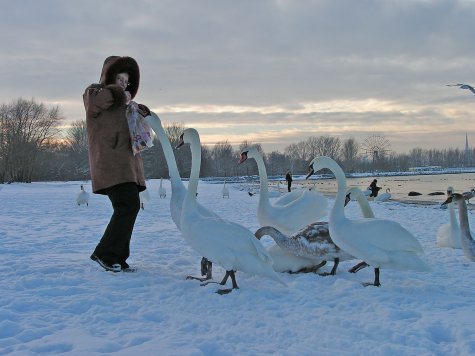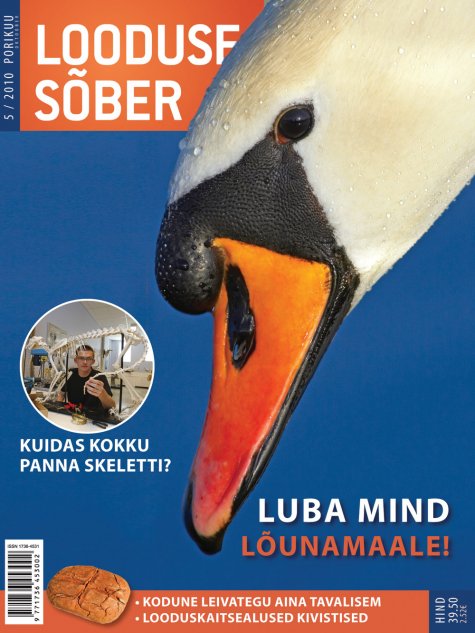Feeding birds – necessary help or unwanted intervention?
The winter feeding house for birds and the piece of lard hanging on its string create nice opportunities to observe the doings of our small neighbours from the window, learning to know the species and observing their interactions with each other. It is better than TV, and is a much more educational window than the Windows in your computer. With waterfowl however things are somewhat different.
The feeding of birds is an excellent tool for education about nature, and for teaching a responsible relationship with nature to children and young people: after having learnt the names and looks of different birds, their habitats and food preferences from when they were small, they are better prepared to consider the aspects of nature too when they grow up and begin to make important decisions - better than those who have grown up only with TV and computers.
But here we will discuss situations where the relations between man and nature can run out of balance, or, specifically, when the feeding of birds is harmless and when it may become a risk for the birds.
Small winter birds should be fed at dawn
When feeding small winter birds and while getting a feeling for nature and a sense of responsibility, we should also know that to our houses in built-up areas only a small number of the species that winter here will come: the great tit and blue tit, marsh tit, nuthatch, bullfinch, greenfinch and others among the more courageous. But most passerines survive the winter in the forest. So we help only some of the species to an easier winter, thus giving them a favour in numbers in spring, in the beginning of the nesting period. Considering those who build nests in the open it isn’t so important but for cavity nesters there will be a competition for nesting locations: woodpecker hollows are after all limited in number. When the more numerous species in spring - numerous due to winter feeding: the great tits, blue tits and nuthatches – occupy the nest hollows then the balance in numbers in relation to the forest species – coal tits and willow tits – may not the same after the winter as it was in autumn. But here the effect of human activity is actually rather small because the cavity nesters who keep near humans occupy places in deciduous and mixed forests and the forest species prefer conifer forests.
Of these the crested tit is the earliest nester, already lying on eggs when the great tit and the blue tit still build nests. But a person feeding birds near a forest could set out a dozen or so of nest boxes to diminish the effect.
The winter feeding house provides a nice opportunity to observe the birds of prey that winter with us and hunt there: sparrowhawk and pygmy owl are the most common ones to visit the dining tables of tits in smaller communities and near parks or forests.
Observing such not very common birds is an additional treat that few get. It is the natural way of events in nature and we should never intervene on the false principle of “look, the hawk caught a tit, we must punish it”. The chance to have seen this should instead be treasured. The situation is quite different when a domestic animal, for instance a cat, is involved. Then it is the human’s responsibility to see that our domesticated animals should not disturb nature’s course of events.
Winter birds should only be offered unsalted food: different kinds of grain, hemp, flax and sunflower seeds, peanuts and similar (NB: peanuts must not be roast or shelled) and of the fattier foods unsalted lard, unsalted margarine, rolled oats added to melted vegetable or pork fat (this can for instance be served in a plastic or metal can hanging upside down and with a wooden peg at the bottom for securing it) and other suitable things. Bread is not recommended.
Salted food causes a craving for water so the birds must drink. And when the only water available is snow then in melting the cold snow the tiny birds loose a great part of the energy that they just got from the feeding table.
Don’t feed waterfowl during their migration period
Things are more complicated with extra feeding of waterfowl. On our latitudes inland waters and coastal waters freeze, but only after the autumn migration is over. The signal for migrating waterfowl to move southwards is not the fall in temperature – this is no problem – but the lessening of their food supply caused by the colder weather. If humans during the autumn migration period offer food to waterfowl, mainly in cities and built-up areas, then the supply of food seems assured and the birds will not go on their migration journey. And so, when the waters freeze as the frosts become more frequent, the birds are caught in a risky situation because in cold weather people won’t go out to bring them food. At the same time the freezing of shore waters starts, bringing the zone of open water so far from the shore that the ducks and swans that feed on plants cannot dive any more to reach down to the bottom to get at the food. In the first place the smaller species get in trouble because the swans that have been lured to winter here are able to reach deeper down for their food and clear the bottoms of food for the smaller ones.
Swans and ducks trapped
Numerous waterfowl winter in Estonia and the number of species is large – about twenty. The greater part of them are diving ducks that spend the winter in the open sea and dive to feed on fish, mussels and other titbits that might please them. The dabbling ducks and the swans keep to the shores where they find food in shallow waters and the seaside pastures and fields. If people don’t interfere by bringing extra food during the autumn months (September to November) sensible birds move on southwards. Those who stay take a risk and in case of a hard winter a great part of them are doomed. Only in such cases is supplementary feeding justified – to help those who didn’t have the sense to migrate or – even more important – who were beguiled into staying by irresponsible feeding in the autumn. Extra feeding in these exceptional circumstances should be done with advice from specialists, because waterfowl need food that is very different from what people are used to offer them. Bread and cakes are definitely unsuitable. Grain too should be provided only restrictedly. Open water at the feeding place should be noted and finely chopped vegetables should be added to the menu. In addition any signs of infectious diseases must be noted. Very weak individuals should be caught and brought in for rehabilitation or taken to coastal areas where the sea is open (generally the western coast). Dead birds must be cleared off and the cause of death determined – sometimes it may be due to unsuitable feeding.
„Bread and cakes” ducks and swans: created by ignorant humans
The most common aquatic birds in parks, the mallards and mute swans, confident and almost behaving as domesticated birds, most often get in distress in winter. Of course we develop a relationship with birds by feeding them and it is an important path for education about nature but certain limits must be respected. Widely distributed information in media about when and why waterfowl should not be fed is necessary, and - if winter feeding must be undertaken - then what is a wholesome diet for them. The information must also be distributed in Russian-language media: people with a Russian background are often close to nature, and their interest in nature is great, but factual information in their native language is almost non-existent.
It is also worth pointing out that although a mute swan – the largest bird in Estonia – who takes food from the hand of a human seems harmless, it will become aggressive during its nesting period and because it has lost its fear of humans due to the feeding, it attacks fiercely. A swan can crush the finger bone of an adult with a single strike of its beak, or break the arm of a child with its wing edge. A swan may seem helpless on the ground but aided by its wings it can run very fast. The mute swan is the most dangerous of all Estonian birds to humans, leaving the cautious eagles and owls far behind. The ignorance of humans about this danger contributes too. A thorough information work in media on the subject of feeding waterfowl is urgently needed










